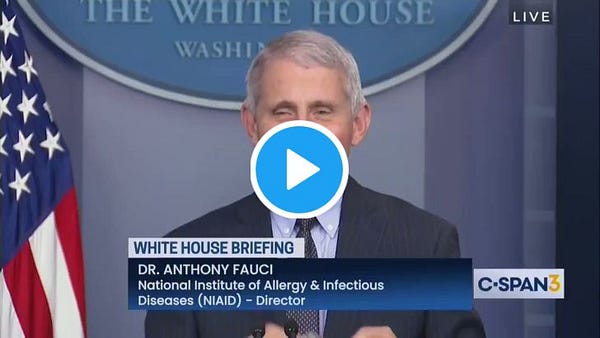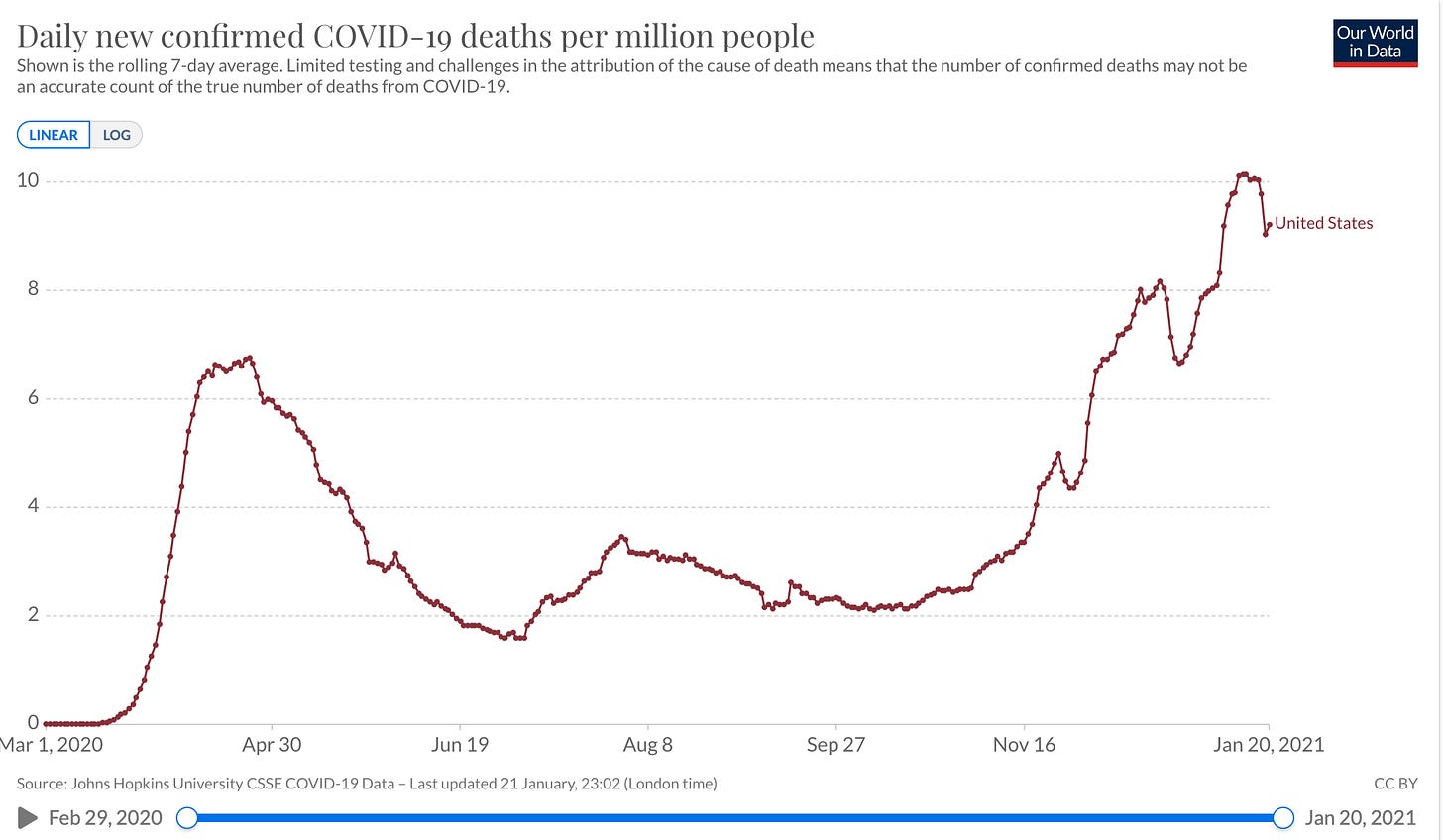COVID-19, Year 2: 📈 US to remain WHO member, 21 January 2021
One year ago today, the CDC announced the first case of COVID-19 in the United States, a man in the Seattle-area who had recently returned from Wuhan, China
A year ago, 21 January 2020, the CDC announced the first case of “travel-related” COVID-19 in the United States.
Fitting, perhaps, that today Dr. Anthony Fauci told the World Health Organization (WHO) executive board that the United States would remain a member nation, reversing the action of the prior administration.
South Korea also reported its first case on 21 January 2020. On 20 January 2021, South Korea reported a per capita case rate of 144.2/100,000 and death rate of 2.57. The US: 7,381.9 cases per 100,000 and 122.7 deaths.
On 20 January 2021, the 366th day of COVID-19 in the US (last year was a leap year), we had a seven-day average of 195,000 daily cases and 3,062 daily deaths (Covid Tracking Project plus current ID/NE/WA data, as they are reported a day late by CTP). The state with the most cases per capita: North Dakota. The most per capita deaths: New Jersey.
Johns Hopkins reported a total of 24,434,282 US cases and 406,001 US deaths on Wednesday 20 January 2021. Globally, the report was 96,787,259 cases and 2,055,593 deaths.
After all this time, the US still accounts for about 1-in-4 coronavirus cases and 1-in-5 deaths, although we have less than 3% of the world’s population.
The patient from Washington with confirmed 2019-nCoV infection returned to the United States from Wuhan on January 15, 2020. The patient sought care at a medical facility in the state of Washington, where the patient was treated for the illness. Based on the patient’s travel history and symptoms, healthcare professionals suspected this new coronavirus. A clinical specimen was collected and sent to CDC overnight, where laboratory testing yesterday confirmed the diagnosis via CDC’s Real time Reverse Transcription-Polymerase Chain Reaction (rRT-PCR) test.
On January 17, 2020, CDC began implementing public health entry screening at Los Angeles (LAX), New York (JFK) and San Francisco (SFO) airports. After the Washington state report, the CDC added entry health screening at Atlanta (ATL) and Chicago (ORD) airports.
21 January 2020


I am getting my first Pfizer shot on Friday. This is the first time that having breast cancer (and recently turning 65) has led to something positive. The vaccination rollout in Washington is flawed, however, because my 86-year-old career Air Force officer father-in-law has yet to hear from the VA. We cannot get him signed up in Snohomish County. The county has public drive-through centers, but little vaccines. Hospitals and clinics have vaccines, but no (easy) way to push through high numbers.
A report from California illustrates the challenge with vaccine distribution. There are 6.2 million people age 65 and over in California, and officials want to vaccinate 70% of them (4.34 million) with two doses.
[T]he state is receiving about 400,000 doses a week, or 500,000 in a good week. At this rate, it could take until June to inject shots into the arms of seniors (emphasis added).
Hopefully, the pace will pick up. On 20 January 2021, the CDC reported it had shipped 35,990,150 doses to the states. On the 21st, 37,960,000 doses. This is far cry from repeated promises from the former administration. For example, from 08 December:
Brett Giroir, the assistant secretary for health administration, told “CBS This Morning” that the U.S. expects to be able to vaccinate about 20 million people this month, 20 million to 25 million in January and another 20 million to 25 million in February with the Pfizer vaccine and another vaccine from drugmaker Moderna, assuming both receive FDA emergency authorization (emphasis added).
CDC reported on 20 January 2021 that 2,394,961 people had received two doses; 15,053,257 had received either one or two doses. January is more than half-over.
Although the US purchased 200 million doses from Pfizer and 200 million from Moderna, these orders will not be fully delivered until mid-year.
With the increased transmission rates of recent virus variants, such as B.1.1.7 out of the UK, vaccination is a race against time.




Where are we today?
The good news is that hospitalizations seem to have plateaued. We are about a month out from the Christmas travel spike. Hospitalizations peaked at 132,474 on 06 January 2021 and have been declining since the 12th. The report on the 20th was that 122,770 people were hospitalized for COVID-19 in the U.S.
States ranking for the year
Cases per 10K (US average, 738)
ND, 1,263
SD, 1,199
UT, 1,024
RI, 1,018
TN, 1,016
WI, 984
NE, 954
AZ, 949
AR, 915
OK, 911
Deaths per 100K (US average 123)
NJ, 233
MA, 199
RI, 194
MS, 189
CT, 189
SD, 188
ND, 185
LA, 180
NY, 172
IL, 160
Covid Tracking Project data
On the last day of the first year of COVID-19, the rolling seven day toll was 1,365,000 cases; 21,436 deaths. Deaths over a rolling seven-day period peaked at 23,357 on Saturday 16 January 2021. This was a 23% increase over the prior peak of 18,992 deaths on Tuesday 22 December 2020 (Covid Tracking Project plus current ID/NE/WA data, which are reported a day late by CTP).
The seven-day rolling average on 20 January 2021: 195,000 cases and 3,062 deaths.
Hot spots, new cases/day, seven-day average
Arizona, 95.8
South Carolina, 95.6
California, 83.8
New York, 73.8
Georgia, 73.1
Rhode Island, 72.7
Virginia 72.0
👓 See COVID-19 resource collection at WiredPen / See all newsletters







